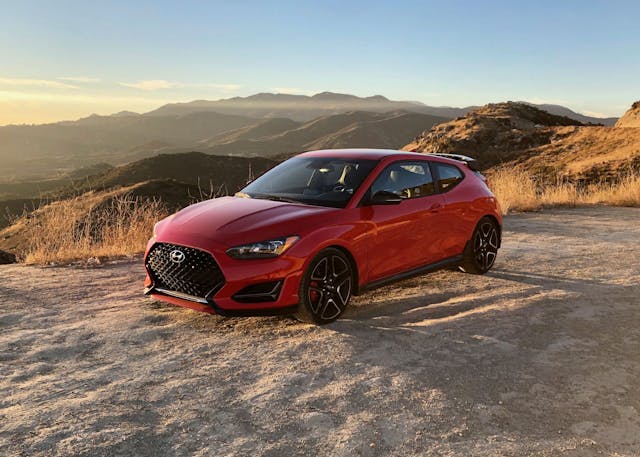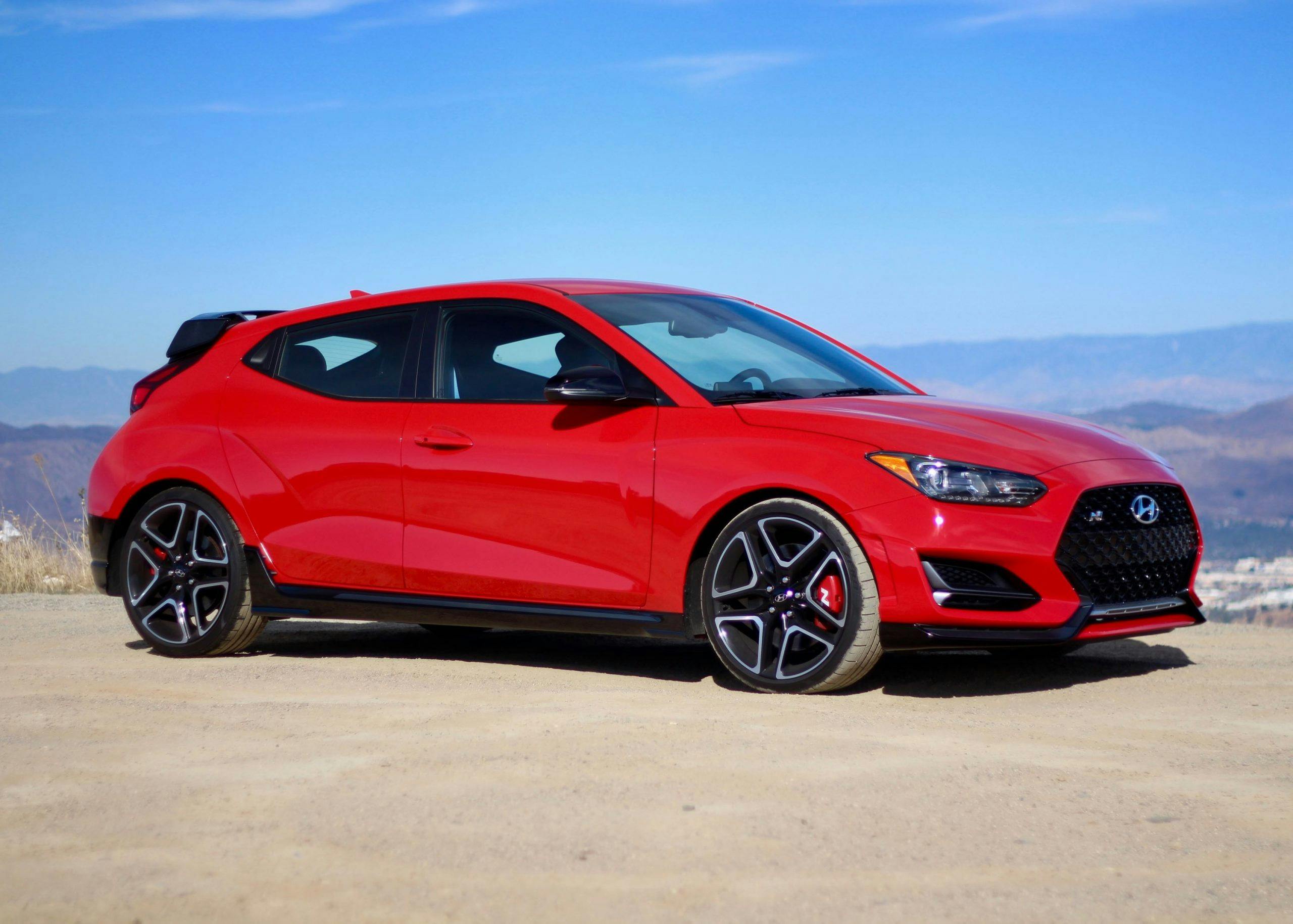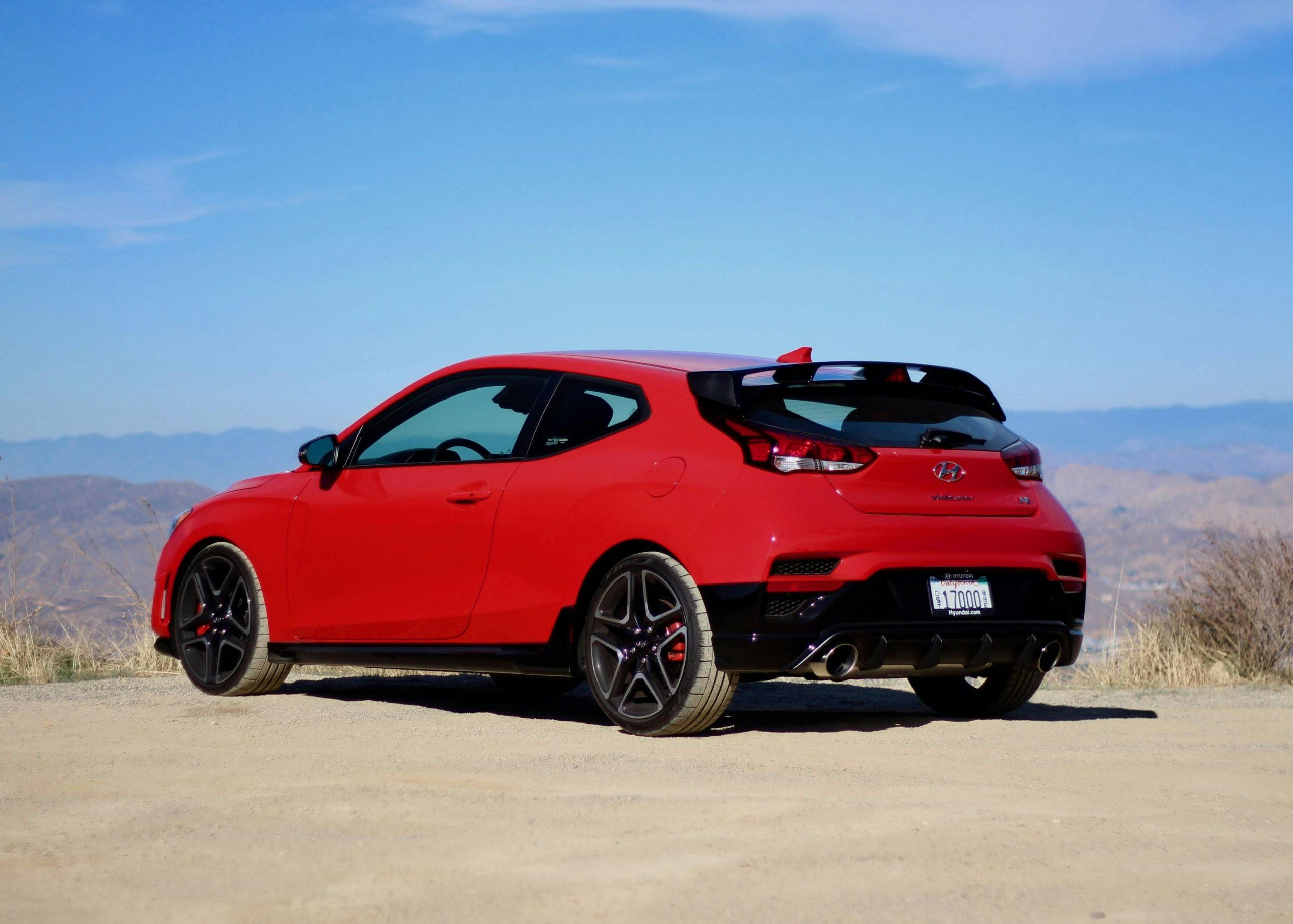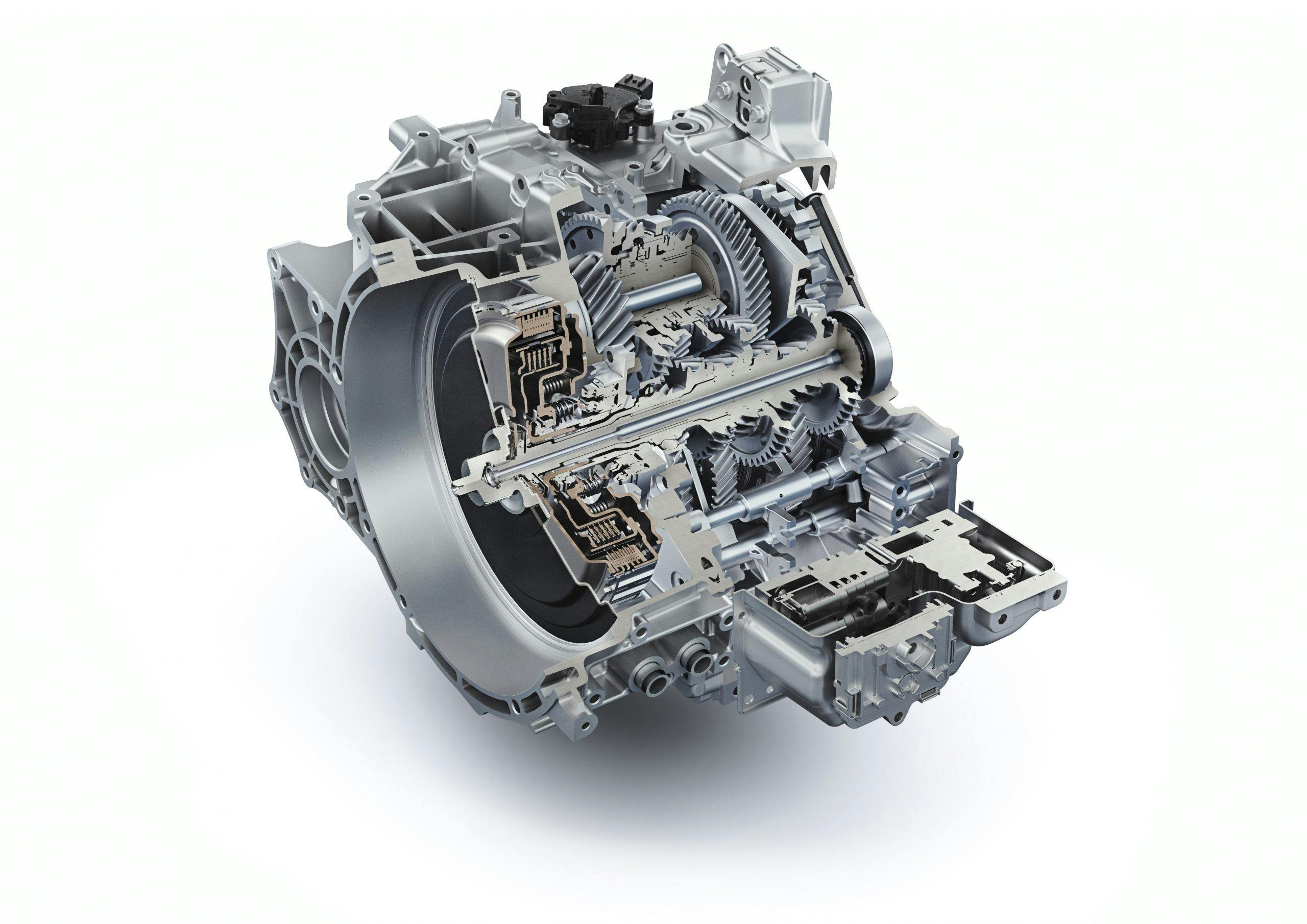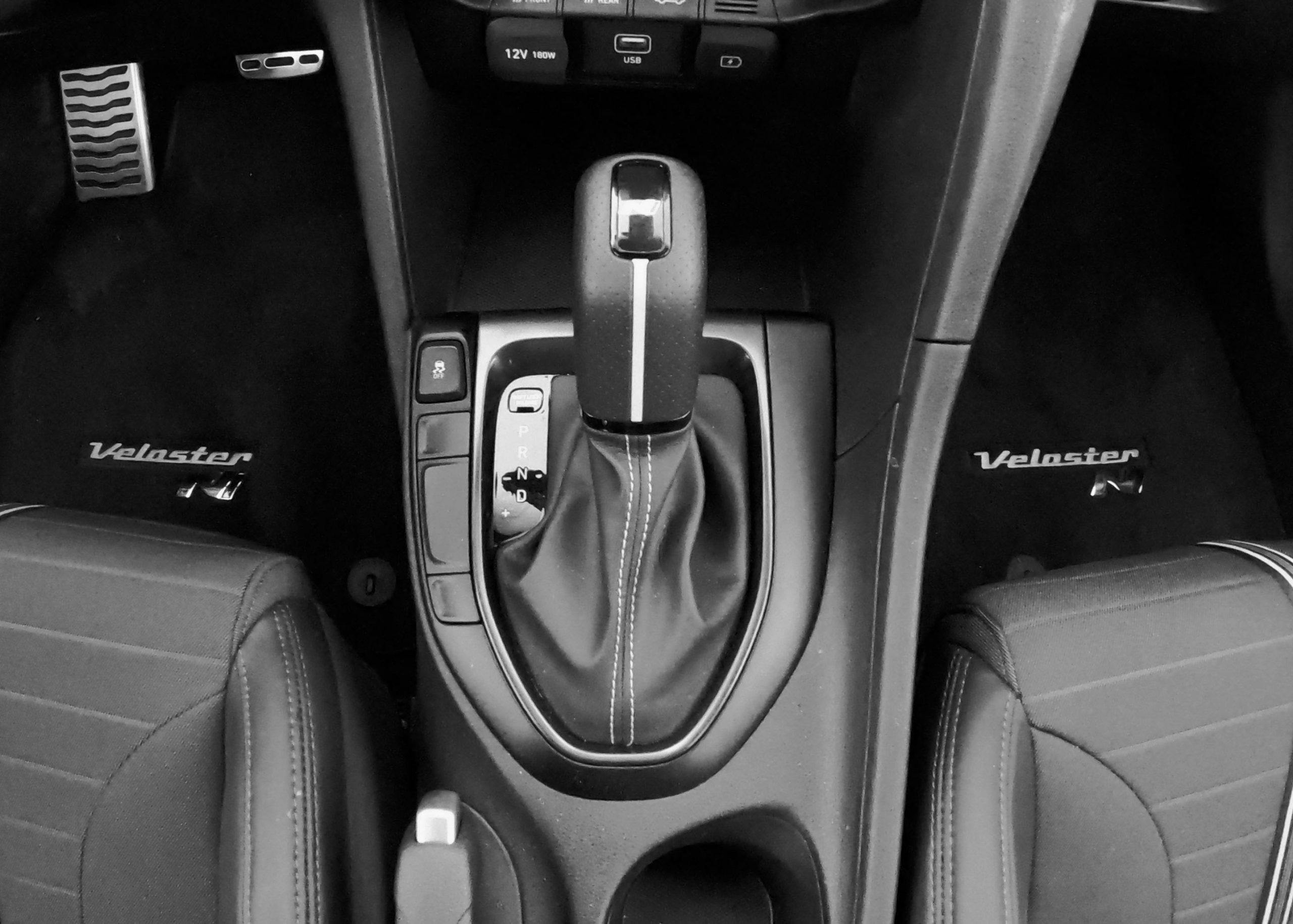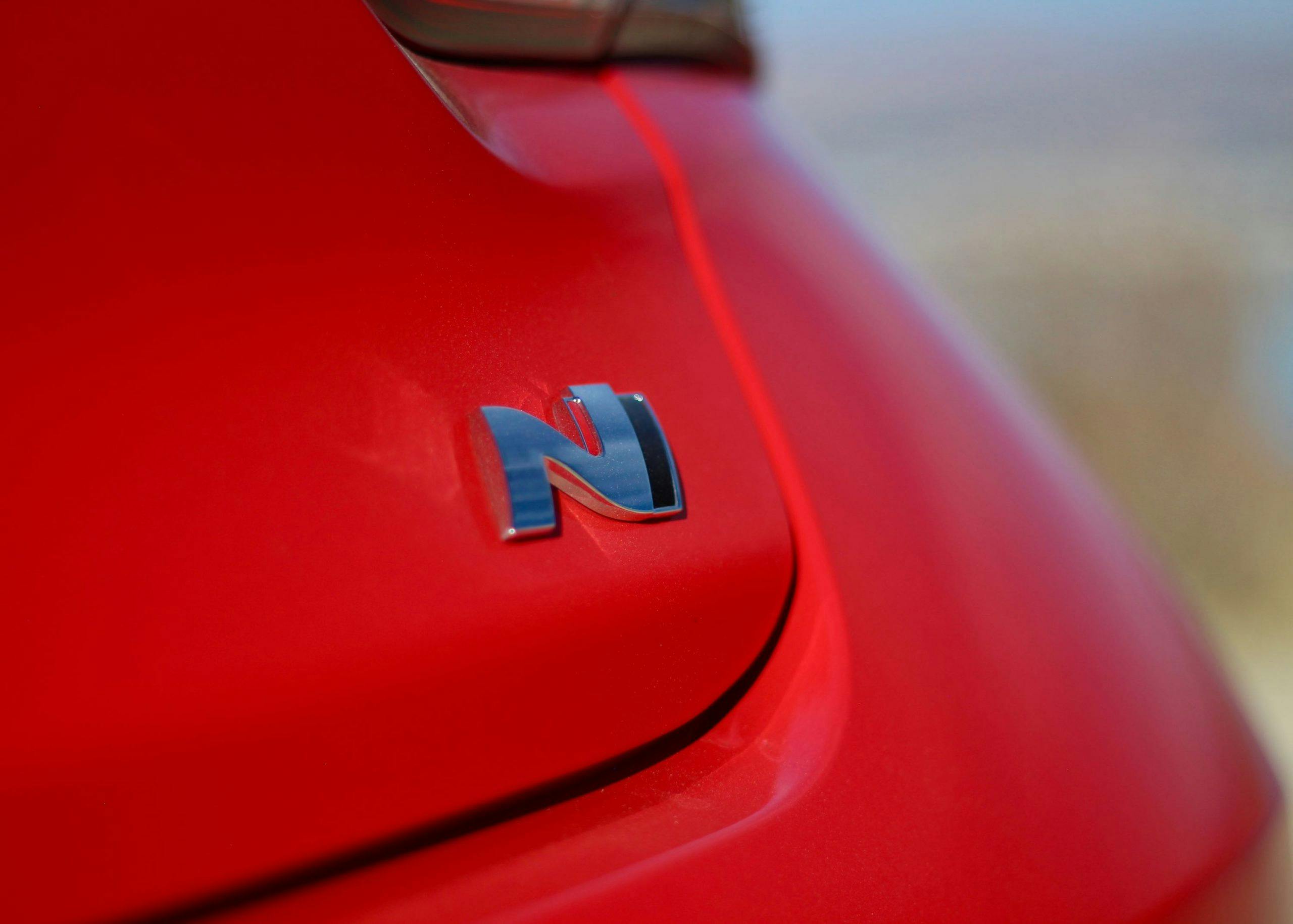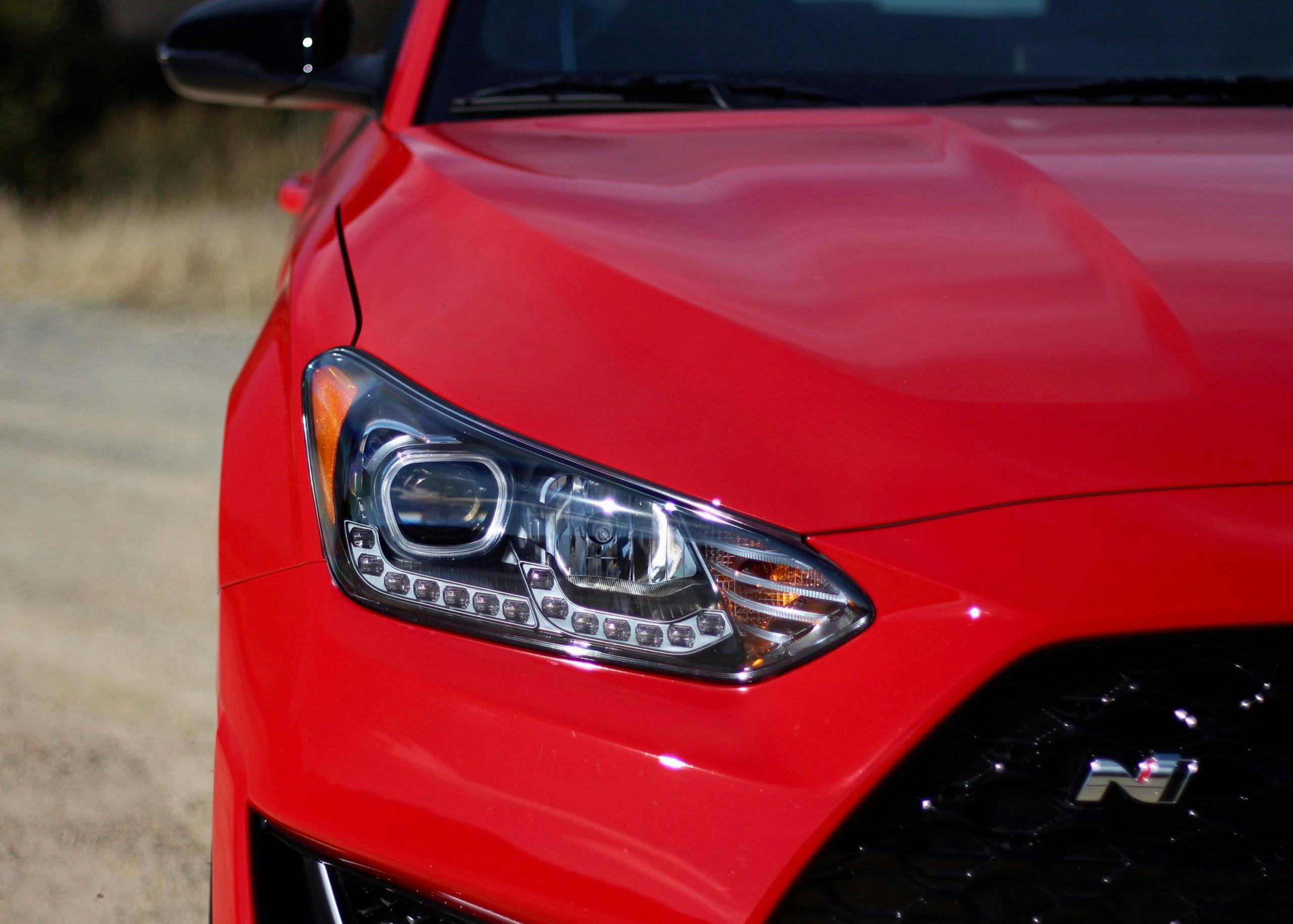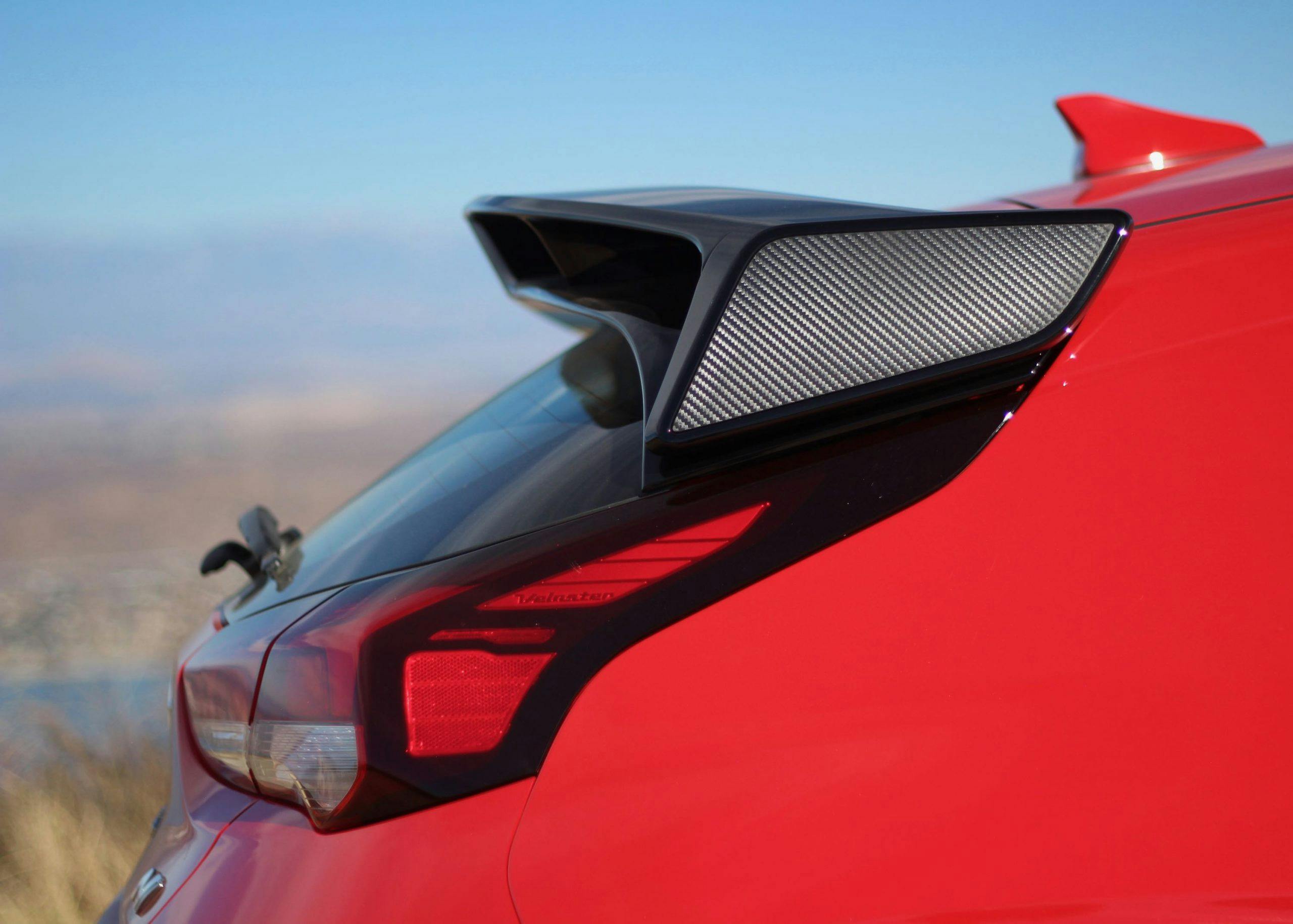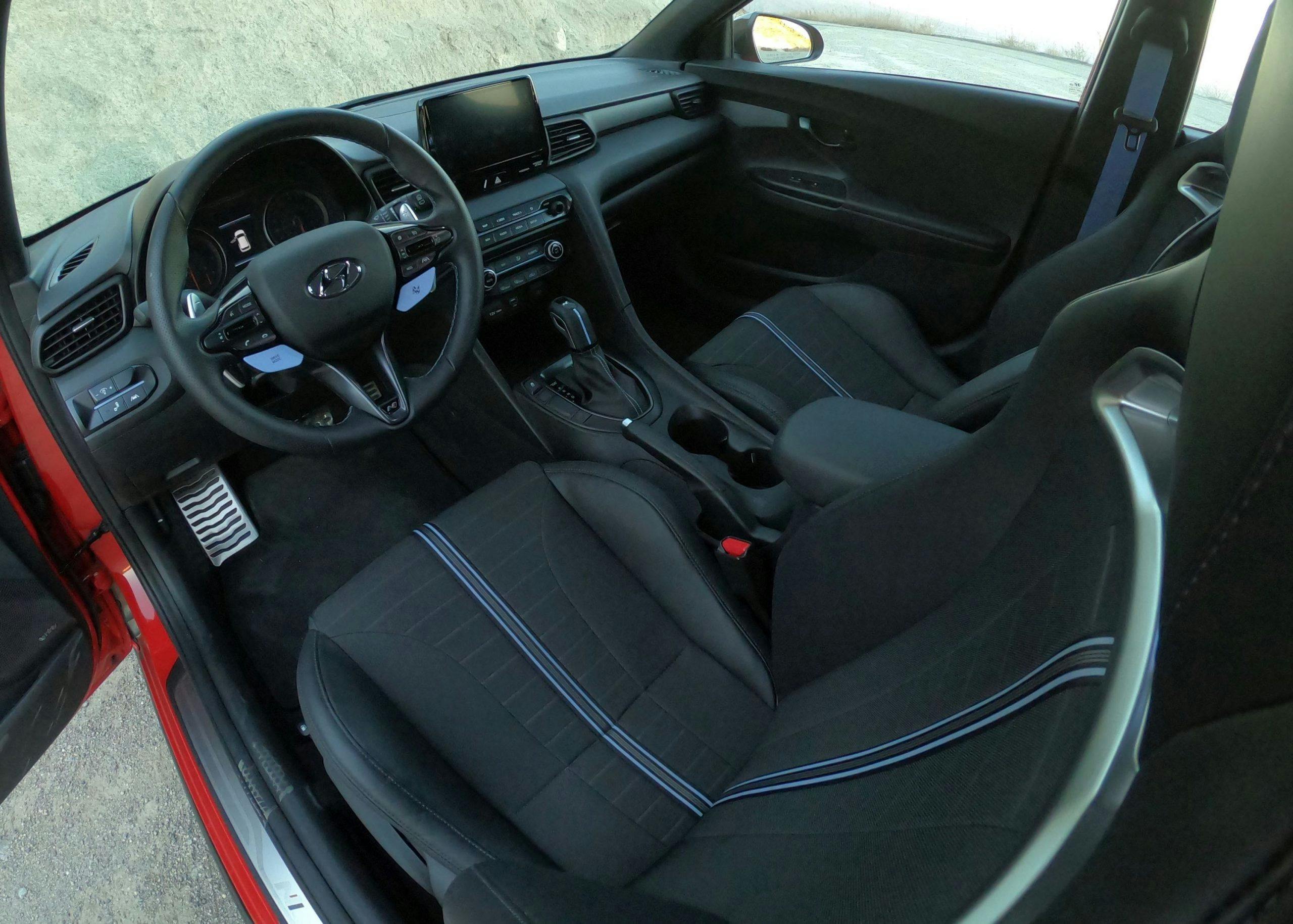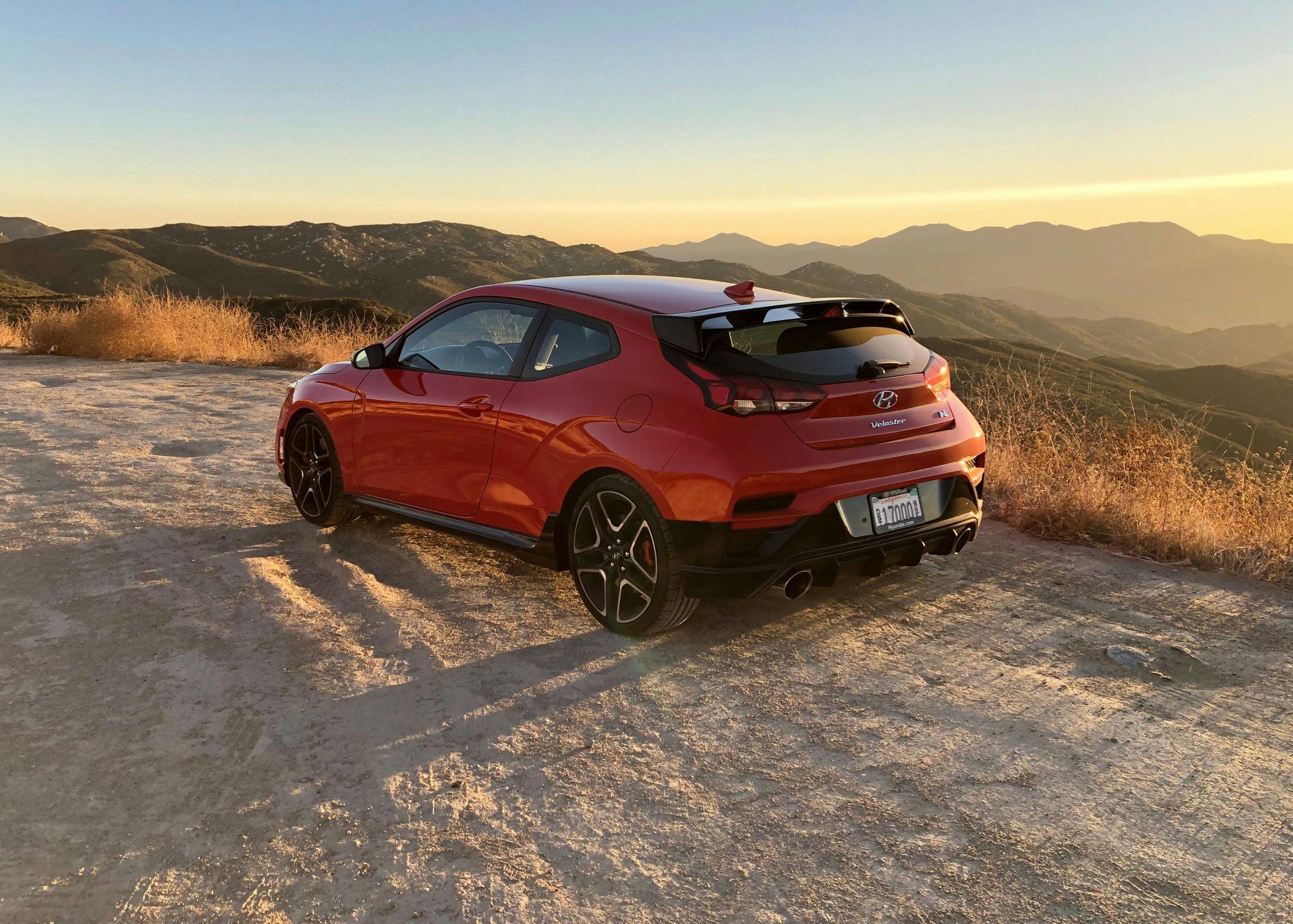Review: 2021 Hyundai Veloster N DCT
As an unabashed devotee of well-sorted front-wheel-drive hot hatches, I didn’t expect much from the Veloster N—until I drove it. In three minutes, this spunky Korean hatch won me over. Sure, its styling may be a little homely to some, but visual quirks are quickly forgotten from the captain’s chair.
For the 2021 model year, Hyundai’s effectively shifted the Veloster upwards in the performance hatch market. The Performance Pack—a 25-hp bump, bigger brakes, an electronic limited-slip diff, and 19-inch wheels clad in Pirelli P-Zeros—now comes standard, and the “base” Veloster N is no more. An eight-speed, dual-clutch automatic (a $1500 option) joins the six-speed manual. A pair of proper chairs resides up front, too. Naturally, Hyundai requires buyers to dip a bit deeper into their wallets for this bevy of goodies: The 2021 Veloster N carries an MSRP of $32,250, $2550 more than its 2020 predecessor equipped with the then-optional $2100 Performance Pack. (For our review of the 2020 six-speed Veloster N Performance Pack, head over here.) Our test vehicle rang the register at $34,745.
The 275-hp Veloster N follows the odd-duck arrangement of the standard model—one door on the driver’s side and two on the passenger side—but the chassis receives additional welds and bracing at the factory to maximize rigidity. Nothing to fear here.
Interior design showcases Hyundai’s characteristically straightforward layout but the overall impression isn’t as refined as that of the Veloster N’s closest competitors, the GTI and the Civic Type R. The Korean’s fit and finish also suffers when compared to its German and Japanese rivals. Even so, the Veloster’s technological accoutrements are satisfactory; the dash is fitted with a fashionable 8.0-inch infotainment screen tacked high on the dash, with secondary analog controls thoughtfully arranged below it.
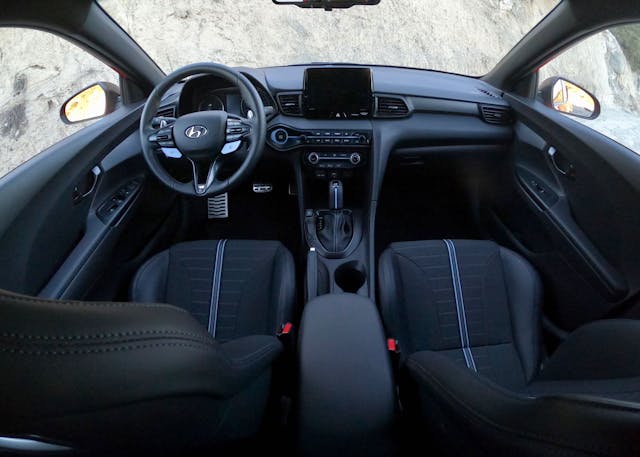
The all-new N Light Sport seats are a blessing. These cloth and pseudo-leather chairs come standard on 2021 models and constitute a much-needed improvement over those in previous Veloster Ns. Manually adjustable and lightweight (Hyundai claims a 4.4-pound weight saving, which is a bit irrelevant compared to the DCT’s 140-pound increase), these two-piece buckets are the answer to drivers’ wishes. They’re perfectly supportive for any sort of driving, including the full range of g-loads that the N can produce.
Forward visibility is respectable, but the view in the rearview mirror is compromised by the sloping roofline. Head room is generous, even for helmeted noggins—a thoughtful detail. If you need or strongly prefer a lower seating position than the buckets offer, you could shorten the seat brackets with the help of a skilled fabricator. The second row is best suited to passengers under five feet, though it’s possible for adults to tolerate the cramped quarters for short durations. The cargo space under the hatch is ample, but I was reminded of its tall lift-over height each morning when I loaded my camera gear.

Though lane-keeping and forward-collision avoidance systems are standard for the 2021 model year (adaptive cruise control is absent), the Veloster N focuses on good ol’ fashioned driver engagement. The drivetrain is the star of the show here. The 2.0-liter, turbocharged four-cylinder makes 275 horsepower at 5800 rpm and 260 lb-ft of torque from 1450 to 4700 rpm. When you hit the NGS button (N Grin Shift, as Hyundai calls it), it provides an additional 18 lb-ft of torque (278) for twenty seconds. Think modest push-to-pass. A modern launch-control function is standard: Set launch rpm, pin both pedals, release left, smile big.
The eight-speed, dual-clutch gearbox is this N’s pièce de résistance. Its wet-clutch design makes the automatic more thermally efficiency than its six-speed, manual counterpart. Though I wasn’t able to thrash this Veloster N on-track during this review, I’m sure owners will chime in about the DCT’s heat tolerance (or lack thereof) after their first track days. Fifth through eighth gears are overdrive.
Power gets to the ground through the aforementioned electronic limited-slip diff. Making the e-diff standard on the Veloster N is a smart move for Hyundai; an electronic LSD wasn’t standard on the GTI until the 2017 model year, and the upcoming Mk. 8 hatch, expected to arrive stateside in late 2021, will have it standard. Honda’s 2021 Type R makes do with a mechanical version. Compared to a mechanical differential, e-diffs have the advantage of optimizing lock across the front axle for optimal acceleration. They can also switch to a fully open setting under braking for stability and driver confidence. The 2021 Veloster N’s setup should help its case in a face-off against the upcoming Mk. 8 GTI.
My love for hot hatches started in the era of the 1.8-liter GTI and the 1.6-liter Civic Si. While I lament the loss of those naturally aspirated mills, the key benefit of modern turbo motors is a torque curve that resembles Australia’s Uluru. With maximum twist available from just off idle to well into the rev range, the N’s 2.0-liter four-banger makes for a less frantic driving experience than those vintage machines, regardless of gearbox choice.
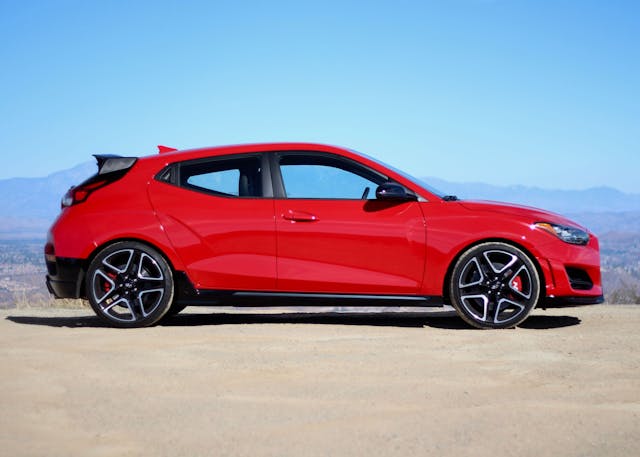
The N engineers have optimized the entire drivetrain. The N Mode button is positioned perfectly at your right thumb, and the first push drops you into N Mode, where all settings are maximized—engine, transmission, differential, dampers, steering, stability control, and exhaust sound. The full salsiccia. Regardless of the drive mode, however, operation is flawless. In more tame drive modes, shifts are smooth and acceleration is effortless thanks to that fat torque curve. In full N mode—or in my preferred Custom mode and its aggressive drivetrain settings—upshifts hit home with a slug to your back.
Thankfully, N engineers have recognized that a custom mode is in order, easily accessible via a second press of the N button. Remembering my initial test of the Veloster N, I set mine with dialed-back settings for maximum steering assist and softest damper modes. There’s no need for the additional, artificial steering heft and, given that California mountain roads aren’t billiard-table smooth, that soft setting allows the dampers to work, ensuring contact patches stay glued to the road surface. A day spent hammering around a road course may demand more aggressive damper response, but we’ll have to save that test for another day.
While the wheel-mounted shift paddles are best suited to the business of driving quickly, the engineering philosophy is driver-first and the shifter’s manual mode orients shift action in the correct manner: Pull for upshift, push for downshift. Steering is electrically-assisted, of course, with a column-mounted assist unit, which serves to mute some feedback from the front contact patches, but the relatively smaller mass of the Veloster ensures clear chassis feel.

Brake feel, feedback, and modulation are remarkably good for a single-piston setup, perhaps owing to the small mass of the Veloster (3186 pounds for the DCT-equipped car). Braking is very effective for day-to-day and canyon-carving purposes, but track-day specialists may want more. There is an elusive Korean-market-only four-piston front brake kit, but no one’s imported it to North America; the aftermarket may resolve that dilemma in the future.
Dynamically, the N shines as a fully-resolved, cohesive package. On corner entry, it’s stable under braking and you can seamlessly transition from the brake to aggressive throttle. No need to baby the throttle here, as the driveline calibrations allow you to be as aggressive as you desire. Understeer rarely, if ever, rears its ugly head.
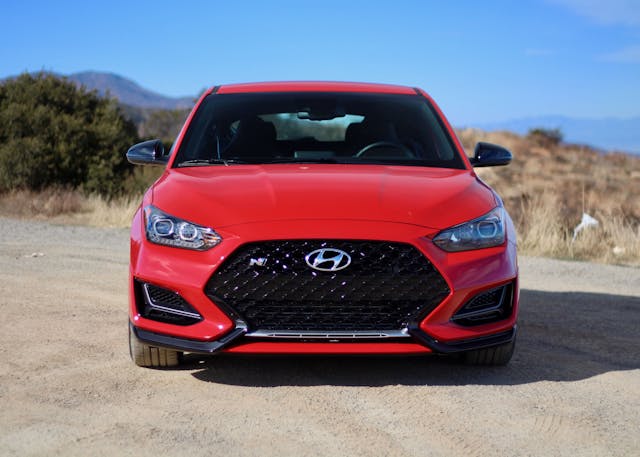
The N offers high levels of grip and its chassis balance is just as neutral as that of the Type R. Rare among front-drivers, the suspension isn’t finished with punishingly high levels of roll stiffness. Rather, N engineers have developed this Veloster with confident chassis balance that isn’t punishing in daily use and is still exceptionally rewarding for those who enjoy more enthusiastic cornering.
The Veloster’s infotainment system receives a digital re-skin for the 2021 model year. Each function is enhanced, whether it’s navigation or the radio and media functions. Save for the custom drive mode tuning, however, the system may be more approachable (for iPhone users) with the standard Apple CarPlay. The seven-speaker Infinity sound system is above average for the segment.
The $33,245 Veloster N splits the difference between an entry-level 2021 VW GTI S, at $29,690, and the 2021 Civic Type R, with its trick dual-axis front suspension and mechanical diff, at $38,890 (all prices include a $995 destination fee). Though the Mk. 7 GTI is testing its best-before date, it’s still a solid value proposition. The true test of the Veloster N’s mettle, however, will occur in 2021, when the Mk. 8 GTI hits U.S. shores.

Hyundai wants to run with the big dogs, and appointing the former BMW M head Albert Biermann as head of research and development was the best thing the company could have done to improve the dynamics of the company’s product lines. The Veloster N is a shining example of his careful touch.
Finally, to those wondering whether the DCT dilutes the proposition, I’ll say this: The automatic is even better resolved than the manual and I didn’t miss the lack of engagement. This Veloster is a hot hatch in the truest sense and an accessible, performance-oriented machine for driving enthusiasts. The pint-sized three-door has established the N brand as a legitimate contender, and drivers will enjoy its highly livable everyday manners along with its robust track-day potential.
2021 Hyundai Veloster N DCT
Price: $34,745 (as tested)
Highs: Perhaps the best front-wheel-drive drivetrain to sniff the tarmac.
Lows: 140 pounds heavier than the manual, and it’s all on the nose.
Summary: A flawlessly engineered hot hatch.
